Mapping Research Trends in Pulsed Electric Field Technology Applied to Biogas Production: A Comprehensive Bibliometric Analysis
Abstract
1. Introduction
- (i)
- To categorize the research output by scientific disciplines to gain insight into the degree of disciplinarity of the PEF method, understand the dominant research areas contributing to this field, and gain insight into the evolution of the field over the years.
- (ii)
- To evaluate and compare the bibliometric potential of four scientific databases (WoSCC, Scopus, Dimensions, and Google Scholar) with regard to their coverage, classification systems, and data overlap, and to reflect on their suitability for bibliometric research.
- (iii)
- To map the evolution of research activity on PEF in biogas production over time, identify publication trends, and growth. This includes a comparative analysis with other substrate pretreatment methods to show how common PEF applications are in biogas research.
- (iv)
- To analyze the application of PEF pretreatment among different substrate types and assess its effects on microbial community structure and activity, to understand how PEF influences both substrate degradability and microbial processes relevant to AD, and to identify under-represented substrate types in the current research field.
- (v)
- To examine research efforts aimed at optimizing operational parameters of PEF pretreatment for enhanced AD performance, and to evaluate the scalability of this technology across batch-, pilot, and full-scale applications, with emphasis on treatment efficiency and energy performance, and to identify gaps related to insufficiently explored parameters and underrepresented system scales.
- (vi)
- To compare the performance of PEF pretreatment with other pretreatment methods in terms of methane yield, substrate solubilization, and energy efficiency.
2. Comparative Overview and Selection Criteria for Bibliometric Databases
3. Search Strategy and Methodology
4. Results and Discussion
4.1. Comparative Bibliometric Analysis of PEF Research Across Databases
4.2. Overview of the Published Studies on PEF Pretreatment Before AD
4.2.1. Substrate Types and Microbial Community Responses
4.2.2. Optimization and Scalability
| Research Size | Substrates | Pretreatment Parameters | Results | Ref. |
|---|---|---|---|---|
| Batch scale | Pig slurry | PEF pretreatment: Stainless-steel electrodes 20 cm long, 0.5 cm wide, and 7 cm high. Exponential decay waveform. delectrode = 1 cm; f = 1.7 Hz; τ = 4 µs; treatment duration = 83 and 90 min; TI = 0, 15, 30, 50 kWhm−3; slurry dosed with circulation pump at a rate of 350 mlmin−1; E = 20 kVcm−1 BMP assay: 1 L batch reactors; T = 37 °C; IS ratio = 1 (based on VS); t = 22 days. | COD removal and CH4 yield increased linearly with higher pretreatment TI—pretreatment TI of 50 kWhm−3 resulted in 58% higher CH4 production and 44% improvement in COD removal as compared to the control. | [20] |
| Batch scale | Chicken manure | PEF pretreatment: Stainless-steel reactor with a coaxial electrode. Rectangular electrical pulses. delectrodes = 2 cm; U = 40 kV; τ = 50 µs; f = 5 kHz; E = 11.66 to 38.66 kVcm−1 BMP assay: T = 37 °C; t = 24 days; mixing: 30 s at 100 rpm every 10 min; IS ratio = 5 (based on VS). | The highest increase in the COD (increased from 5957 ± 71 to 6973 ± 85 mgL−1) and TOC (increased from 1922 ± 48 to 2252 mgL−1) was obtained after pretreatment with specific energy input 0.26 Whg−1 TS. Increased BMP from 210.42 ± 7.92 to 248.90 ± 9.29 mlg−1 VS. Negative energy balance in all pretreatment conditions. | [21] |
| Batch scale | Microalgae Auxenochlorella protothecoides | PEF pretreatment: Plane-parallel stainless-steel electrodes. delectrodes = 4 mm; E = 40 kVcm−1; f = 3 Hz; τ = 1 µs; Wspec. = 150 kJkg−1 BMP assay: T = 38 °C; t = 38 days; IS ratio = 0.36 to 0.38 (based on VS). | If compared to untreated, PEF pretreated microalgae showed a 10% increased CH4 yield (467 mLnormg−1 VS). PEF pretreated microalgae subjected to extraction and removal of aqueous fraction showed a 23% increase in CH4 yield (558 mLnormg−1 VS). PEF pretreated microalgae subjected to extraction and removal of aqueous fraction and lipids achieved 41% of CH4 potential (205 mLnormg−1 VS) | [72] |
| Batch scale | WAS and pig manure | PEF pretreatment: Cylindrical treatment chamber. U = 10 kV; τ = 10 µs; f = 1000 Hz; σ = 0.1 Sm−1; L = 0.01 m; HRT = 0.01 s WAS: TI = 4.0, 9.9, 19.8 kWhm−3; E = 24.5 kVcm−1 Manure: TI = 7.0, 10.5 kWhm−3; E = 19.7 kVcm−1 BMP assay: t = 30 days; T = 35 °C. | PEF pretreatment solubilized approximately 10% of the total COD, increasing SCOD from as low as 20 mgL−1 to more than 1000 mgL−1. BMP was increased for pig manure by 80%, and for WAS by 100% | [76] |
| Batch scale | WAS | PEF pretreatment: Co-linear cylindrical stainless-steel treatment chamber. U = 0–36 kV; f = 0.1–50 Hz BMP assay: t = 37 days; T = mesophilic conditions. | The CH4 production increased 1.70 times. An 18% improvement in SCOD and a 19% improvement in VSS were observed when compared to the control. | [30] |
| Batch scale | Maize silage | PEF pretreatment: Coaxial 500 mL chamber, stainless-steel electrodes. delectrodes = 2 cm; U = 40 kV; τ = 50 µs; f = 10 kHz; rectangular pulse shape; Emin = 11.66 kVcm−1; Emax = 38.61 kVcm−1; tPEF = 0, 30, 60, 90, 120, 150, 180, 210, 240, and 270 s BMP assay: IS ratio = 5; T = 35 °C; t = 24 days. | A 14% higher biogas yield (at tPEF 180 s for 751.97 mLg−1 VS) compared to the control. | [91] |
| Batch scale | Grass silage | PEF pretreatment: Coaxial 500 mL chamber, stainless-steel electrodes. delectrodes = 2 cm; U = 40 kV; τ = 50 µs; f = 5 kHz; Emin = 11.66 kVcm−1; Emax = 38.66 kVcm−1 BMP assay: IS ratio = 5; T = 35 °C; t = 24 days. | A 20% higher biogas yield compared to the control. | [68] |
| Batch scale | Rapeseed straw | PEF pretreatment: Coaxial 500 mL chamber, stainless steel electrodes. delectrodes = 2 cm; U = 40 kV; τ = 50 µs; f = 5 kHz; rectangular pulse shape; Emin = 11.66 kVcm−1; Emax = 38.61 kVcm−1; tPEF = 0, 1, 2, 3, 4, 5, 6, 7, 8 min. BMP assay: IS ratio = 5; T = 37 °C; t = 24 days. | A 5-min PEF pretreatment resulted in about 14% higher biogas yield compared to the control sample. The biogas productivity for this sample was 478.0 ± 27.5 NmLg−1 VS, approximately 15% higher than the control sample. Due to the energy gain, the sample disintegrated for 4 min was the most effective, yielding 0.06 Whg−1 TS. | [69] |
| Full scale | WAS + thickened primary sludge | PEF pretreatment: full-scale OpenCELTM FP unit installed at the water reclamation plant between the centrifuges and the two digesters to treat the mixture sludges; E = 20–30 kV AD: HRT = 30–35 days; T = 35–38 °C. | FP pretreatment of a mixture of sludges increased the SCOD by 160% and the DOC by 120% over the control. FP pretreatment of 63% of the input sludge increased biogas production by over 40% and reduced biosolids requiring disposal by 30% when compared to the control. | [79] |
| Pilot scale | A mixture of 55%TS corn silage and 45%TS cattle manure | PEF combined with shock waves. PEF pretreatment: continuous PVC chamber; τ = 1 μs; U = 30 kV; pulse repetition rate: 15 pulses/s; pulse duration: 5–20 μs. Electrophoresis power supply: 1000 V, 250 W voltage source and a transistorized full bridge (H-bridge) connected downstream. The shock wave generated by a high-performance piezo ceramic using a high-voltage pulse at ~36 kHz. The piezo disks diameter: 5 cm, thickness: 8 mm. The breakdown field strength: 1 kVmm−1. AD: loading increased from 2.5 kg0TSm−3d−1 to 3.5 kg0TSm−3d−1 in daily steps of 0.2 kg0TSm−3d−1; HRT = 30 days; T = 37–38 °C Pilot plant: 2 digesters (2 × 200 L fermentation volume) and 2 secondary digesters (2 × 100 L fermentation volume). | No significant increase in specific biogas or methane production was observed with PEF + shock wave treatment in comparison to control; no biological instability or inhibition; frequent clogging occurred, mostly in the untreated line; the authors suppose that the benefits could be more pronounced with homogeneous or less fibrous substrates. | [90] |
| Batch scale | Wastewater sludge | PEF pretreatment: TI = 4, 20, 70, and 95 kJ/kg BMP assay: continuous stirred-tank reactors (CSTR) of 10 L capacity; T = 55 °C; HRT = 10.5 days. | Increases of 7.3% in cumulative biogas production and 7% in VS reduction were obtained from the AD of mixed primary and secondary sludge pretreated with an intensity of 95 kJ/kg. | [92] |
| Batch scale | Degreased food waste + sewage sludge (ratio 1:1); addition of biochar to enhance AD | PEF pretreatment: carbon felt electrodes (4 × 4 × 0.5 cm). The electric field was supplied in three stages, 0–10, 11–20, and 21–30 days, and connected to a stabilized voltage of U = 0.3, 0.6, and 0.9 V, respectively. BMP assay: T = 55 °C; shaking incubator at 100 rpm; t = 30 days. | Under U = 0.3 V, coupled with 5 gL−1 of biochar, resulted in a 143% growth in biogas production. Increased methane production (by 45.5% compared to the biochar-only test) by enriching hydrogenotrophic methanogens such as Methanobacterium, enhancing DIET associated with electroactive bacteria, and weakening acetolactate methanogenic capacity. Efficient utilization of VFA and accelerated ammonia nitrogen removal in the early stages, thereby improving the start-up efficiency of AD. | [65] |
| Batch scale | Source-separated food waste | PEF pretreatment: E = 24 kVcm−1; f = 12.5 Hz. BMP assay: continuous reactors; T = 37 °C; t = 98 days. | BMP tests indicated up to a 50% increase in the total biogas potential. The largest amount of energy used was 500 J (kg TS)−1 per pulse. The methane formation increased from 222 to 338 Lkg−1 TS. | [88] |
| Batch scale | Biological sludge from the pulp and paper wastewater treatment | PEF pretreatment: Substrate was poured into a 250 mL cylinder cuvette (length 20 cm, diameter 4 cm); U = 36 kV; I = 40 mA; f = ~10.5 Hz. E = ~10 kVcm−1; n = 2000 (2 × 1000, due to equipment limitation), each pulse corresponding to an energy consumption of 54.4 J. BPM assay: semi-continuous digester; HRT = 20 days; T = 37 °. The digesters were fed once a day (200 mL substrate) and stirred 15 min every hour (400–500 rpm). | No or little effect on the initial methane production rate or methane potential was achieved. | [93] |
| Batch scale | Food waste | HVPD pretreatment: The ground plate electrode is a stainless-steel disc (with a diameter of 90 mm and a thickness of 1.5 mm). The pulse peak voltage amplitude = 50 kV; f = 100, 200, 200 and 400 Hz; storage capacitance (Cp) = 2 nF; delectrodes = 5, 7, 9, 12 mm; tPEF = 5, 10, 15, 20, 30 min BMP assay: shaking incubator at 100 r/min, T = 35 °C. | The total cumulative methane production of the HVPD pretreated substrate was 134% higher than that of the control. The final VS transformation rates with and without HVPD pretreatment were 54.3% and 32.3%, respectively. Comparison of HVPD pretreatment with acid, alkali, and ultrasonic pretreatments showed that the methane production and COD removal rates with HVPD were more than 100% higher than the control, whereas about 50% higher can be obtained with other pretreatments. | [73] |
4.2.3. Comparative Analysis of PEF with Other Pretreatment Methods
4.3. Global Research Distribution and Key Contributors to PEF Pretreatment in Biogas Research
5. Conclusions and Future Directions
- Extending full-scale validations across various feedstocks and digester configurations to evaluate process robustness and long-term performance.
- Enhancing process standardization, particularly in the reporting of key PEF parameters and treating chamber specifications, to enable comparability across studies.
- Expanding microbial analysis beyond lab-scale conditions to monitor community dynamics, functional gene expression, and pathway regulation in complex microbial consortia.
- Developing hybrid or synergistic pretreatment strategies, combining PEF with different pretreatment methods optimized for specific substrate characteristics. For example, PEF could be integrated with enzymatic hydrolysis to enhance accessibility of lignocellulosic biomass, with ultrasound to intensify cell disruption, or with mild alkaline or chemical pretreatments to improve solubilization of recalcitrant substrates.
- Conducting comprehensive techno-economic assessments and life cycle analyses to evaluate energy efficiency, cost-effectiveness, and environmental impacts under scaled-up conditions. A major gap identified in the reviewed literature is the lack of standardized and comparable energy balance assessments. Only a few PEF studies report input–output energy data, and often in inconsistent formats, which prevents fair benchmarking against alternative pretreatment methods. Future work should therefore prioritize systematic energy analyses to evaluate the true efficiency and competitiveness of PEF relative to other approaches.
Funding
Data Availability Statement
Conflicts of Interest
References
- Archana, K.; Visckram, A.S.; Senthil Kumar, P.; Manikandan, S.; Saravanan, A.; Natrayan, L. A Review on Recent Technological Breakthroughs in Anaerobic Digestion of Organic Biowaste for Biogas Generation: Challenges towards Sustainable Development Goals. Fuel 2024, 358, 130298. [Google Scholar] [CrossRef]
- Kunatsa, T.; Xia, X. A Review on Anaerobic Digestion with Focus on the Role of Biomass Co-Digestion, Modelling and Optimisation on Biogas Production and Enhancement. Bioresour. Technol. 2022, 344, 126311. [Google Scholar] [CrossRef]
- Boarino, A.; Demichelis, F.; Vindrola, D.; Robotti, E.; Marengo, E.; Martin, M.; Deorsola, F.; Padoan, E.; Celi, L. Bio-Physical Pre-Treatments in Anaerobic Digestion of Organic Fraction of Municipal Solid Waste to Optimize Biogas Production and Digestate Quality for Agricultural Use. Waste Manag. 2024, 189, 114–126. [Google Scholar] [CrossRef]
- Chettri, D.; Verma, A.K.; Ghosh, S.; Verma, A.K. Biogas from Lignocellulosic Feedstock: Current Status and Challenges. Environ. Sci. Pollut. Res. 2024, 31, 1–26. [Google Scholar] [CrossRef] [PubMed]
- Khan, R.; Jolly, R.; Fatima, T.; Shakir, M. Extraction Processes for Deriving Cellulose: A Comprehensive Review on Green Approaches. Polym. Adv. Technol. 2022, 33, 2069–2090. [Google Scholar] [CrossRef]
- Karthikeyan, P.K.; Bandulasena, H.C.H.; Radu, T. A Comparative Analysis of Pre-Treatment Technologies for Enhanced Biogas Production from Anaerobic Digestion of Lignocellulosic Waste. Ind. Crops Prod. 2024, 215, 118591. [Google Scholar] [CrossRef]
- Bocker, R.; Silva, E.K. Pulsed Electric Field Technology as a Promising Pre-Treatment for Enhancing Orange Agro-Industrial Waste Biorefinery. RSC Adv. 2024, 14, 2116–2133. [Google Scholar] [CrossRef]
- Capodaglio, A.G. Pulse Electric Field Technology for Wastewater and Biomass Residues’ Improved Valorization. Processes 2021, 9, 736. [Google Scholar] [CrossRef]
- Buchmann, L.; Mathys, A. Perspective on Pulsed Electric Field Treatment in the Bio-Based Industry. Front. Bioeng. Biotechnol. 2019, 7, 265. [Google Scholar] [CrossRef]
- Pereira, R.N.; Rodrigues, R.; Avelar, Z.; Leite, A.C.; Leal, R.; Pereira, R.S.; Vicente, A. Electrical Fields in the Processing of Protein-Based Foods. Foods 2024, 13, 577. [Google Scholar] [CrossRef]
- Šalaševičius, A.; Uždavinytė, D.; Visockis, M.; Ruzgys, P.; Šatkauskas, S. Comparative Analysis of Pulsed Electric Fields (PEF) and Traditional Pasteurization Techniques: Comparative Effects on Nutritional Attributes and Bacterial Viability in Milk and Whey Products. Appl. Sci. 2023, 13, 12127. [Google Scholar] [CrossRef]
- Barba, F.J.; Parniakov, O.; Pereira, S.A.; Wiktor, A.; Grimi, N.; Boussetta, N.; Saraiva, J.A.; Raso, J.; Martin-Belloso, O.; Witrowa-Rajchert, D.; et al. Current Applications and New Opportunities for the Use of Pulsed Electric Fields in Food Science and Industry. Food Res. Int. 2015, 77, 773–798. [Google Scholar] [CrossRef]
- Töpfl, S. (PDF) Pulsed Electric Fields (PEF) for Permeabilization of Cell Membranes in Food-and Bioprocessing: Applications, Process and Equipment Design and Cost Analysis. Available online: https://www.researchgate.net/publication/228894256_Pulsed_Electric_Fields_PEF_for_Permeabilization_of_Cell_Membranes_in_Food-and_Bioprocessing_Applications_Process_and_Equipment_Design_and_Cost_Analysis (accessed on 31 July 2025).
- Kotnik, T.; Frey, W.; Sack, M.; Haberl Meglič, S.; Peterka, M.; Miklavčič, D. Electroporation-Based Applications in Biotechnology. Trends Biotechnol. 2015, 33, 480–488. [Google Scholar] [CrossRef] [PubMed]
- Golberg, A.; Sack, M.; Teissie, J.; Pataro, G.; Pliquett, U.; Saulis, G.; Töpfl, S.; Miklavcic, D.; Vorobiev, E.; Frey, W. Energy-Efficient Biomass Processing with Pulsed Electric Fields for Bioeconomy and Sustainable Development|Biotechnology for Biofuels and Bioproducts. Available online: https://link.springer.com/article/10.1186/s13068-016-0508-z (accessed on 30 April 2025).
- Davalos, R.V.; Mir, I.L.M.; Rubinsky, B. Tissue Ablation with Irreversible Electroporation. Ann. Biomed. Eng. 2005, 33, 223–231. [Google Scholar] [CrossRef] [PubMed]
- Dermol, J.; Pakhomova, O.N.; Pakhomov, A.G.; Miklavčič, D. Cell Electrosensitization Exists Only in Certain Electroporation Buffers. PLoS ONE 2016, 11, e0159434. [Google Scholar] [CrossRef]
- Kranjc, M.; Kranjc Brezar, S.; Serša, G.; Miklavčič, D. Contactless Delivery of Plasmid Encoding EGFP in Vivo by High-Intensity Pulsed Electromagnetic Field. Bioelectrochemistry 2021, 141, 107847. [Google Scholar] [CrossRef]
- Pagant, S.; Liberatore, R.A. In Vivo Electroporation of Plasmid DNA: A Promising Strategy for Rapid, Inexpensive, and Flexible Delivery of Anti-Viral Monoclonal Antibodies. Pharmaceutics 2021, 13, 1882. [Google Scholar] [CrossRef]
- Safavi, S.M.; Unnthorsson, R. Enhanced Methane Production from Pig Slurry with Pulsed Electric Field Pre-Treatment. Environ. Technol. 2018, 39, 479–489. [Google Scholar] [CrossRef]
- Szwarc, D.; Nowicka, A.; Zieliński, M. Comparison of the Effects of Pulsed Electric Field Disintegration and Ultrasound Treatment on the Efficiency of Biogas Production from Chicken Manure. Appl. Sci. 2023, 13, 8154. [Google Scholar] [CrossRef]
- Matorevhu, A. Bibliometrics: Application Opportunities and Limitations. In Bibliometrics—An Essential Methodological Tool for Research Projects; IntechOpen: London, UK, 2024; ISBN 978-0-85466-802-1. [Google Scholar]
- Öztürk, O.; Kocaman, R.; Kanbach, D.K. How to Design Bibliometric Research: An Overview and a Framework Proposal. Rev. Manag. Sci. 2024, 18, 3333–3361. [Google Scholar] [CrossRef]
- Hoang, A.-D. Evaluating Bibliometrics Reviews: A Practical Guide for Peer Review and Critical Reading. Eval. Rev. 2025, 0193841X251336839. [Google Scholar] [CrossRef] [PubMed]
- Passas, I. Bibliometric Analysis: The Main Steps. Encyclopedia 2024, 4, 1014–1025. [Google Scholar] [CrossRef]
- Aria, M.; Cuccurullo, C. Bibliometrix: An R-Tool for Comprehensive Science Mapping Analysis. J. Informetr. 2017, 11, 959–975. [Google Scholar] [CrossRef]
- Zupic, I.; Čater, T. Bibliometric Methods in Management and Organization. Organ. Res. Methods 2015, 18, 429–472. [Google Scholar] [CrossRef]
- Kovačić, Đ.; Rupčić, S.; Kralik, D.; Jovičić, D.; Spajić, R.; Tišma, M. Pulsed Electric Field: An Emerging Pretreatment Technology in a Biogas Production. Waste Manag. 2021, 120, 467–483. [Google Scholar] [CrossRef]
- Wang, B.; Chen, T.; Qin, X.; Wu, Q.; Zhao, Y.; Bai, S.; Peng, W.; Feng, B. Effect of High-Voltage Pulsed Electric Field (HPEF) Pretreatment on Biogas Production Rates of Hybrid Pennisetum by Anaerobic Fermentation. Nat. Gas Ind. B 2018, 5, 48–53. [Google Scholar] [CrossRef]
- Kuşçu, Ö.; Çömlekçi, S.; Çört, N. Disintegration of Sewage Sludge Using Pulsed Electrical Field Technique: PEF Optimization, Simulation, and Anaerobic Digestion. Environ. Technol. 2022, 43, 2809–2824. [Google Scholar] [CrossRef]
- Donthu, N.; Kumar, S.; Mukherjee, D.; Pandey, N.; Lim, W.M. How to Conduct a Bibliometric Analysis: An Overview and Guidelines. J. Bus. Res. 2021, 133, 285–296. [Google Scholar] [CrossRef]
- Boyack, K.; Klavans, R. Creation of a Highly Detailed, Dynamic, Global Model and Map of Science. J. Am. Soc. Inf. Sci. Technol. 2014, 65, 670–685. [Google Scholar] [CrossRef]
- Ozturk, O. Bibliometric Review of Resource Dependence Theory Literature: An Overview. Manag. Rev. Q. 2021, 71, 525–552. [Google Scholar] [CrossRef]
- Jing, Y.; Wang, C.; Chen, Y.; Wang, H.; Yu, T.; Shadiev, R. Bibliometric Mapping Techniques in Educational Technology Research: A Systematic Literature Review. Educ. Inf. Technol. 2024, 29, 9283–9311. [Google Scholar] [CrossRef]
- Pranckutė, R. Web of Science (WoS) and Scopus: The Titans of Bibliographic Information in Today’s Academic World. Publications 2021, 9, 12. [Google Scholar] [CrossRef]
- Baas, J.; Schotten, M.; Plume, A.M.; Cote, G.; Karimi, R. Scopus as a Curated, High-Quality Bibliometric Data Source for Academic Research in Quantitative Science Studies. MIT Press J. 2020, 1, 377–386. [Google Scholar] [CrossRef]
- Birkle, C.; Pendlebury, D.A.; Schnell, J.; Adams, J. Web of Science as a Data Source for Research on Scientific and Scholarly Activity. Quant. Sci. Stud. 2020, 1, 363–376. [Google Scholar] [CrossRef]
- Singh, V.K.; Singh, P.; Karmakar, M.; Leta, J.; Mayr, P. The Journal Coverage of Web of Science, Scopus and Dimensions: A Comparative Analysis. Scientometrics 2021, 126, 5113–5142. [Google Scholar] [CrossRef]
- Chadegani, A.A.; Salehi, H.; Yunus, M.M.; Farhadi, H.; Fooladi, M.; Farhadi, M.; Ebrahim, N.A. A Comparison between Two Main Academic Literature Collections: Web of Science and Scopus Databases. Asian Soc. Sci. 2013, 9, p18. [Google Scholar] [CrossRef]
- Dallas, T.; Gehman, A.-L.; Farrell, M. Variable Bibliographic Database Access Could Limit Reproducibility. BioScience 2018, 68, 552–553. [Google Scholar] [CrossRef]
- Bianco, M.; Gras, N.; Sutz, J. Academic Evaluation: Universal Instrument? Tool for Development? Minerva 2016, 54, 399–421. [Google Scholar] [CrossRef]
- Lim, M. The Building of Weak Expertise: The Work of Global University Rankers. High. Educ. 2018, 75, 415–430. [Google Scholar] [CrossRef]
- Safón, V. Inter-Ranking Reputational Effects: An Analysis of the Academic Ranking of World Universities (ARWU) and the Times Higher Education World University Rankings (THE) Reputational Relationship. Scientometrics 2019, 121, 897–915. [Google Scholar] [CrossRef]
- Vernon, M.M.; Balas, E.A.; Momani, S. Are University Rankings Useful to Improve Research? A Systematic Review. PLoS ONE 2018, 13, e0193762. [Google Scholar] [CrossRef]
- Van Noorden, R. Google Scholar Pioneer on Search Engine’s Future. Nature 2014. [Google Scholar] [CrossRef]
- Delgado López-Cózar, E.; Orduna-Malea, E.; Martín-Martín, A. Google Scholar as a Data Source for Research Assessment; Springer: Berlin/Heidelberg, Germany, 2018. [Google Scholar]
- Martín-Martín, A.; Thelwall, M.; Orduna-Malea, E.; Delgado López-Cózar, E. Google Scholar, Microsoft Academic, Scopus, Dimensions, Web of Science, and OpenCitations’ COCI: A Multidisciplinary Comparison of Coverage via Citations. Scientometrics 2021, 126, 871–906. [Google Scholar] [CrossRef] [PubMed]
- Halevi, G.; Moed, H.; Bar-Ilan, J. Suitability of Google Scholar as a Source of Scientific Information and as a Source of Data for Scientific Evaluation—Review of the Literature. J. Informetr. 2017, 11, 823–834. [Google Scholar] [CrossRef]
- Clarivate Who We Are—Clarivate. Available online: https://wokinfo.com/about/whoweare/ (accessed on 4 August 2025).
- McNamara, G. LibGuides: Web of Science: Introduction. Available online: https://dcu.libguides.com/c.php?g=701483&p=5040855 (accessed on 25 June 2025).
- Elsevier Elsevier|A Global Leader for Advanced Information and Decision Support in Science and Healthcare. Available online: https://www.elsevier.com (accessed on 4 August 2025).
- Harling, L. Scopus Data Crosses the 100 Million Item Threshold! Elsevier Scopus Blog: Amsterdam, The Netherlands, 2025. [Google Scholar]
- Delgado-Quirós, L.; Ortega, J.L. Completeness Degree of Publication Metadata in Eight Free-Access Scholarly Databases. Quant. Sci. Stud. 2024, 5, 31–49. [Google Scholar] [CrossRef]
- Dimensions. The Largest Linked Research Database|Dimensions Data. Available online: https://www.dimensions.ai/dimensions-data/ (accessed on 5 July 2025).
- Hook, D.W.; Porter, S.J.; Herzog, C. Dimensions: Building Context for Search and Evaluation. Front. Res. Metr. Anal. 2018, 3, 23. [Google Scholar] [CrossRef]
- Mouratidis, R.W. Dimensions. J. Med. Libr. Assoc. JMLA 2019, 107, 459–461. [Google Scholar] [CrossRef]
- Kovačić, Đ.; Samac, D.; Radočaj, D. Research Progress on Biogas Production from Lignocellulose Pretreated with Ultrasound Based on Bibliometric Analysis. In Proceedings of the 60th Croatian and 20th International Symposium on Agriculture, Bol-Brač, Croatia, 1–6 June 2025. [Google Scholar]
- Kousha, K.; Thelwall, M. Google Books, Scopus, Microsoft Academic, and Mendeley for Impact Assessment of Doctoral Dissertations: A Multidisciplinary Analysis of the UK. Quant. Sci. Stud. 2020, 1, 479–504. [Google Scholar] [CrossRef]
- Kovačić, Đ.; Kralik, D.; Rupčić, S.; Jovičić, D.; Spajić, R.; Tišma, M. Electroporation of Harvest Residues for Enhanced Biogas Production in Anaerobic Co-Digestion with Dairy Cow Manure. Bioresour. Technol. 2019, 274, 215–224. [Google Scholar] [CrossRef]
- Alagöz, B.A.; Erdinçler, A.; Yenigün, O. Comparison of Ultrasonic, Microwave, Pulsed Electric Field and Alkali Pre-Treatments in the Biogas Production from Wastewater Sludges; Water Environment Federation: Alexandria, VA, USA, 2015. [Google Scholar]
- Deng, Y.D.; Gao, Y.; Men, Y.K.; Du, B.X.; Wang, Y.N.; Liu, C.H. Effect of DC Corona on Performance of Pulsed Electric Field Pretreatment on Waste Activated Sludge. In Proceedings of the 2016 IEEE Conference on Electrical Insulation and Dielectric Phenomena (CEIDP), Toronto, ON, Canada, 16–19 October 2016; pp. 747–750. [Google Scholar]
- Gao, Y.; Deng, Y.D.; Zhang, J.; Liu, F.J.; Men, Y.K.; Wang, Z.; Du, B.X. Effect of Pulsed Electric Field on Pretreatment Efficiency in Anaerobic Digestion of Excess Sludge. In Proceedings of the 2015 IEEE 11th International Conference on the Properties and Applications of Dielectric Materials (ICPADM), Sydney, Australia, 19–22 July 2015; pp. 840–843. [Google Scholar]
- Ki, D.; Parameswaran, P.; Rittmann, B.E.; Torres, C.I. Effect of Pulsed Electric Field Pretreatment on Primary Sludge for Enhanced Bioavailability and Energy Capture. Environ. Eng. Sci. 2015, 32, 831–837. [Google Scholar] [CrossRef]
- Kopplow, O.; Barjenbruch, M.; Heinz, V. Sludge Pre-Treatment with Pulsed Electric Fields. Water Sci. Technol. J. Int. Assoc. Water Pollut. Res. 2004, 49, 123–129. [Google Scholar] [CrossRef]
- Liu, H.; He, P.; Chen, Y.; Wang, X.; Zou, R.; Xing, T.; Xu, S.; Wu, C.; Maurer, C.; Lichtfouse, E. Coupling of Biogas Residue Biochar and Low-Magnitude Electric Fields Promotes Anaerobic Co-Digestion of Sewage Sludge and Food Waste. Water Sci. Technol. 2024, 89, 2118–2131. [Google Scholar] [CrossRef] [PubMed]
- Yang, M.; Vander Elst, M.; Smets, I.; Zhang, H.; Li, S.; Baeyens, J.; Deng, Y. Reviewing Improved Anaerobic Digestion by Combined Pre-Treatment of Waste-Activated Sludge (WAS). Sustainability 2024, 16, 6419. [Google Scholar] [CrossRef]
- Alawad, I.; Laforge, P.; Wagner, D.; Xiao, H.; Hu, J.; Ibrahim, H. Pulsed Electric Field Pretreatment of Flax Straw: The Effect of Particle Size. Available online: https://www.mdpi.com/2673-4591/76/1/99 (accessed on 28 July 2025).
- Szwarc, D.; Nowicka, A.; Głowacka, K. Cross-Comparison of the Impact of Grass Silage Pulsed Electric Field and Microwave-Induced Disintegration on Biogas Production Efficiency. Energies 2022, 15, 5122. [Google Scholar] [CrossRef]
- Szwarc, D.; Głowacka, K. Increasing the Biogas Potential of Rapeseed Straw Using Pulsed Electric Field Pre-Treatment. Energies 2021, 14, 8307. [Google Scholar] [CrossRef]
- Wang, J.; Ma, D.; Lou, Y.; Ma, J.; Xing, D. Optimization of Biogas Production from Straw Wastes by Different Pretreatments: Progress, Challenges, and Prospects. Sci. Total Environ. 2023, 905, 166992. [Google Scholar] [CrossRef]
- Garoma, T.; Shackelford, T. Electroporation of Chlorella Vulgaris to Enhance Biomethane Production. Bioresour. Technol. 2014, 169, 778–783. [Google Scholar] [CrossRef]
- Straessner, R.; Nikolausz, M.; Silve, A.; Nazarova, N.; Wuestner, R.; Papachristou, I.; Akaberi, S.; Leber, K.; Mueller, G.; Frey, W. Holistic Exploitation of Pulsed Electric Field (PEF)-Treated and Lipid Extracted Microalgae Auxenochlorella Protothecoides, Utilizing Anaerobic Digestion (AD). Algal Res. 2023, 69, 102950. [Google Scholar] [CrossRef]
- Zou, L.; Ma, C.; Liu, J.; Li, M.; Ye, M.; Qian, G. Pretreatment of Food Waste with High Voltage Pulse Discharge towards Methane Production Enhancement. Bioresour. Technol. 2016, 222, 82–88. [Google Scholar] [CrossRef]
- El Achkar, J.H.; Lendormi, T.; Salameh, D.; Louka, N.; Maroun, R.G.; Lanoisellé, J.-L.; Hobaika, Z. Influence of Pretreatment Conditions on Lignocellulosic Fractions and Methane Production from Grape Pomace. Bioresour. Technol. 2018, 247, 881–889. [Google Scholar] [CrossRef]
- Lee, I.-S.; Rittmann, B.E. Effect of Low Solids Retention Time and Focused Pulsed Pre-Treatment on Anaerobic Digestion of Waste Activated Sludge. Bioresour. Technol. 2011, 102, 2542–2548. [Google Scholar] [CrossRef]
- Salerno, M.B.; Lee, H.-S.; Parameswaran, P.; Rittmann, B.E. Using a Pulsed Electric Field as a Pretreatment for Improved Biosolids Digestion and Methanogenesis. Water Environ. Res. 2009, 81, 831–839. [Google Scholar] [CrossRef] [PubMed]
- Bartha, C.; Jipa, M.; Caramitu, A.-R.; Voina, A.; Tokos, A.; Circiumaru, G.; Micu, D.-D. Behavior of Microorganisms from Wastewater Treatments in Extremely Low-Frequency Electric Field. Biointerface Res. Appl. Chem. 2022, 12, 5071–5080. [Google Scholar] [CrossRef]
- Tooke, M.; Henricksson, P. AD Pre-Treatment—Pulsed Electric Fields in Comparison to Other Pre-Treatment Methods (THP, Enzymatic, Steam Explosion etc.). In Proceedings of the 22nd European Biosolids & Organic Resources Conference & Exhibition, Leeds, UK, 20–21 November 2018. [Google Scholar]
- Rittmann, B.E.; Lee, H.; Zhang, H.; Alder, J.; Banaszak, J.E.; Lopez, R. Full-Scale Application of Focused-Pulsed Pre-Treatment for Improving Biosolids Digestion and Conversion to Methane. Water Sci. Technol. J. Int. Assoc. Water Pollut. Res. 2008, 58, 1895–1901. [Google Scholar] [CrossRef] [PubMed]
- US EPA. Environmental Protection Agency. Available online: https://www.epa.gov/home (accessed on 29 July 2025).[Green Version]
- Zhang, H.; Banaszak, J.E.; Parameswaran, P.; Alder, J.; Krajmalnik-Brown, R.; Rittmann, B.E. Focused-Pulsed Sludge Pre-Treatment Increases the Bacterial Diversity and Relative Abundance of Acetoclastic Methanogens in a Full-Scale Anaerobic Digester. Water Res. 2009, 43, 4517–4526. [Google Scholar] [CrossRef]
- Pasalari, H.; Gharibi, H.; Darvishali, S.; Farzadkia, M. The Effects of Different Pretreatment Technologies on Microbial Community in Anaerobic Digestion Process: A Systematic Review. J. Environ. Health Sci. Eng. 2024, 22, 439–453. [Google Scholar] [CrossRef]
- Akram, J.; Song, C.; El Mashad, H.M.; Chen, C.; Zhang, R.; Liu, G. Advances in Microbial Community, Mechanisms and Stimulation Effects of Direct Interspecies Electron Transfer in Anaerobic Digestion. Biotechnol. Adv. 2024, 76, 108398. [Google Scholar] [CrossRef]
- Pasalari, H.; Gholami, M.; Rezaee, A.; Esrafili, A.; Farzadkia, M. Perspectives on Microbial Community in Anaerobic Digestion with Emphasis on Environmental Parameters: A Systematic Review. Chemosphere 2021, 270, 128618. [Google Scholar] [CrossRef] [PubMed]
- Kuşçu, Ö.S.; Çömlekçi, S. Using of Pulsed Electrical Field (PEF) as an Innovative Technology for Sludge Pretreatment. In Proceedings of the ISITES 2015—3rd International Symposium on Innovative Technologies in Engineering and Science, Valencia, Spain, 3–5 June 2015. [Google Scholar]
- Lindmark, J. Developing the Anaerobic Digestion Process through Technology Integration. Ph.D. Thesis, Mälardalen University, Vasteras, Sweden, 2014. [Google Scholar]
- Lindmark, J.; Lagerkvist, A.; Nilsson, E.; Carlsson, M.; Thorin, E.; Dahlquist, E. Evaluating the Effects of Electroporation Pre-Treatment on the Biogas Yield from Ley Crop Silage. Appl. Biochem. Biotechnol. 2014, 174, 2616–2625. [Google Scholar] [CrossRef]
- Carlsson, M.; Lagerkvist, A.; Ecke, H. Electroporation for Enhanced Methane Yield from Municipal Solid Waste. In Proceedings of the ORBIT 2008: Moving Organic Waste Recycling Towards Resource Management and Biobased Economy 13/10/2008-15/10/200, Wageningen, The Netherlands, 13–15 October 2008. [Google Scholar]
- Appels, L.; Houtmeyers, S.; Van Impe, J.; Dewil, R. Intensification of the Anaerobic Digestion of Waste Activated Sludge by Pulsed Electric Field Technology—KU Leuven. Available online: https://kuleuven.limo.libis.be/discovery/fulldisplay/lirias1461572/32KUL_KUL:Lirias (accessed on 29 July 2025).
- Echtermeyer, D.; Chroszielewski, S.; Krause, W.; Schneider, G.; Brutscher, J.; Müller, U.; Krebs, C.; Schäfer, F.; Beckmann, D.; Pliquett, U. Untersuchung Zur Desintegration von Gärmedien in Einer Parallel Betriebenen Pilotbiogasanlage. Agric. Eng. Eu 2021, 76, 124–140. [Google Scholar] [CrossRef]
- Szwarc, D.; Szwarc, K. Use of a Pulsed Electric Field to Improve the Biogas Potential of Maize Silage. Energies 2021, 14, 119. [Google Scholar] [CrossRef]
- Matilde, M. Pulse Electric Field as a Pre-Treatment Method of Wastewater Sludge Prior to Anaerobic Digestion. Master’s Thesis, Lund University Library, Lund, Sweden, 2020. [Google Scholar]
- Cardell, L. Anaerobic Digestion of Pre-Treated Biological Sludge from Pulp and Paper Industry Using Heat, Alkali and Electroporation. Ph.D. Thesis, Luleå University of Technology, Luleå, Sweden, 2010. [Google Scholar]
- Xie, Y.; Lin, B. A Dynamic Perspective on “Not in My Backyard” Effects: Comparing Public Attitudes toward Waste-to-Energy Power Plants in First-Tier Cities of China from 2019 to 2024. J. Environ. Manag. 2025, 383, 125534. [Google Scholar] [CrossRef] [PubMed]
- Zhong, S.; Zhou, Z.; Zhang, X.; Jin, D. Green Fiscal Interventions and Air Quality Improvement: Empirical Insights on PM2.5 Reduction from Chinese Counties. Clean Technol. Environ. Policy 2025, 27, 4771–4795. [Google Scholar] [CrossRef]
- Azam, W.; Khan, I.; Ali, S.A. Alternative Energy and Natural Resources in Determining Environmental Sustainability: A Look at the Role of Government Final Consumption Expenditures in France. Environ. Sci. Pollut. Res. 2023, 30, 1949–1965. [Google Scholar] [CrossRef]
- Ridwan, M.; Raihan, A.; Ahmad, S.; Karmakar, S.; Paul, P. Environmental Sustainability in France: The Role of Alternative and Nuclear Energy, Natural Resources, and Government Spending. J. Environ. Energy Econ. 2023, 2, 1–16. [Google Scholar] [CrossRef]
- CNRS. CNRS and INRAE Strengthen Their Scientific Cooperation to Achieve the Sustainable Development Goals|CNRS. Available online: https://www.cnrs.fr/en/press/cnrs-and-inrae-strengthen-their-scientific-cooperation-achieve-sustainable-development-goals (accessed on 4 August 2025).
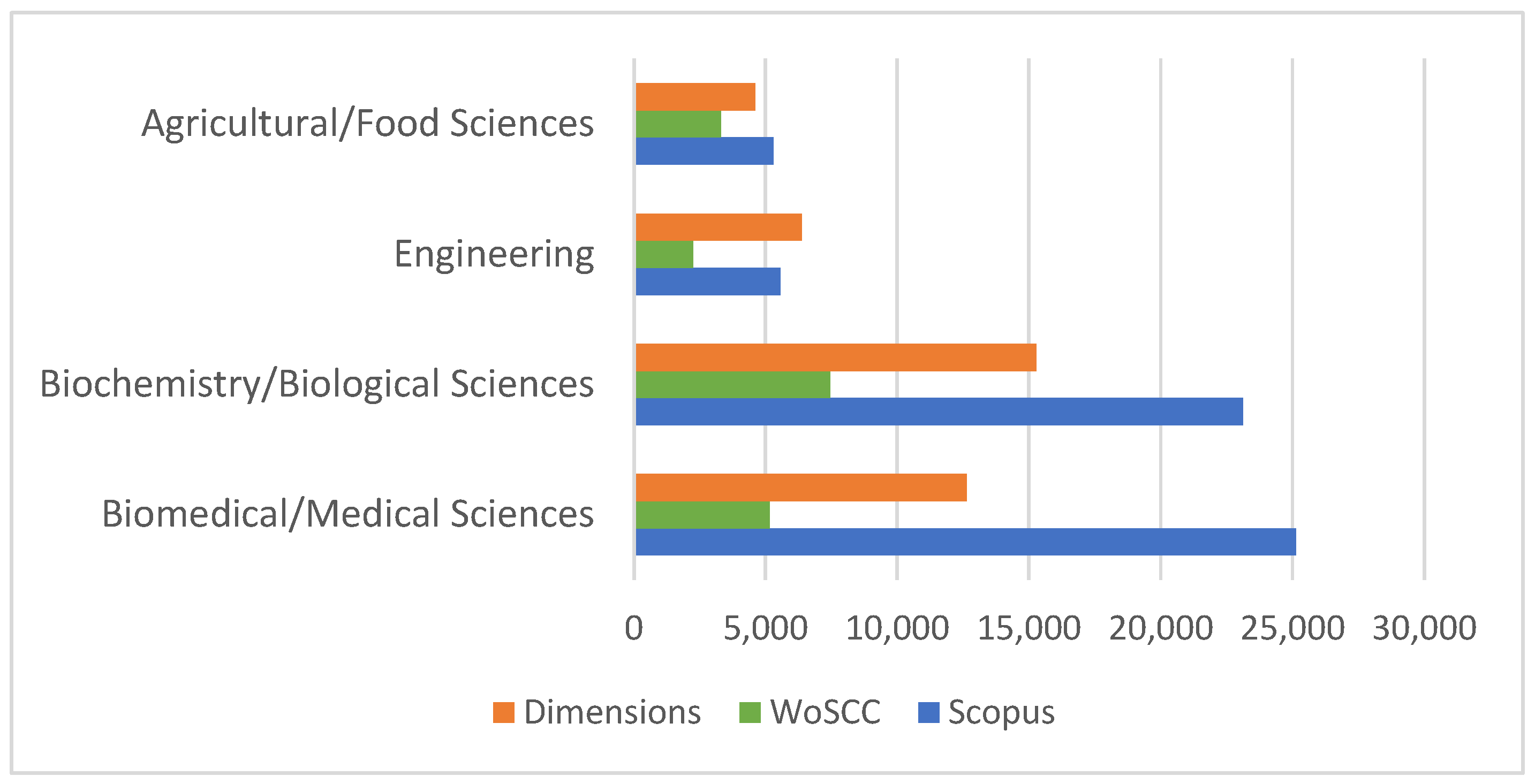
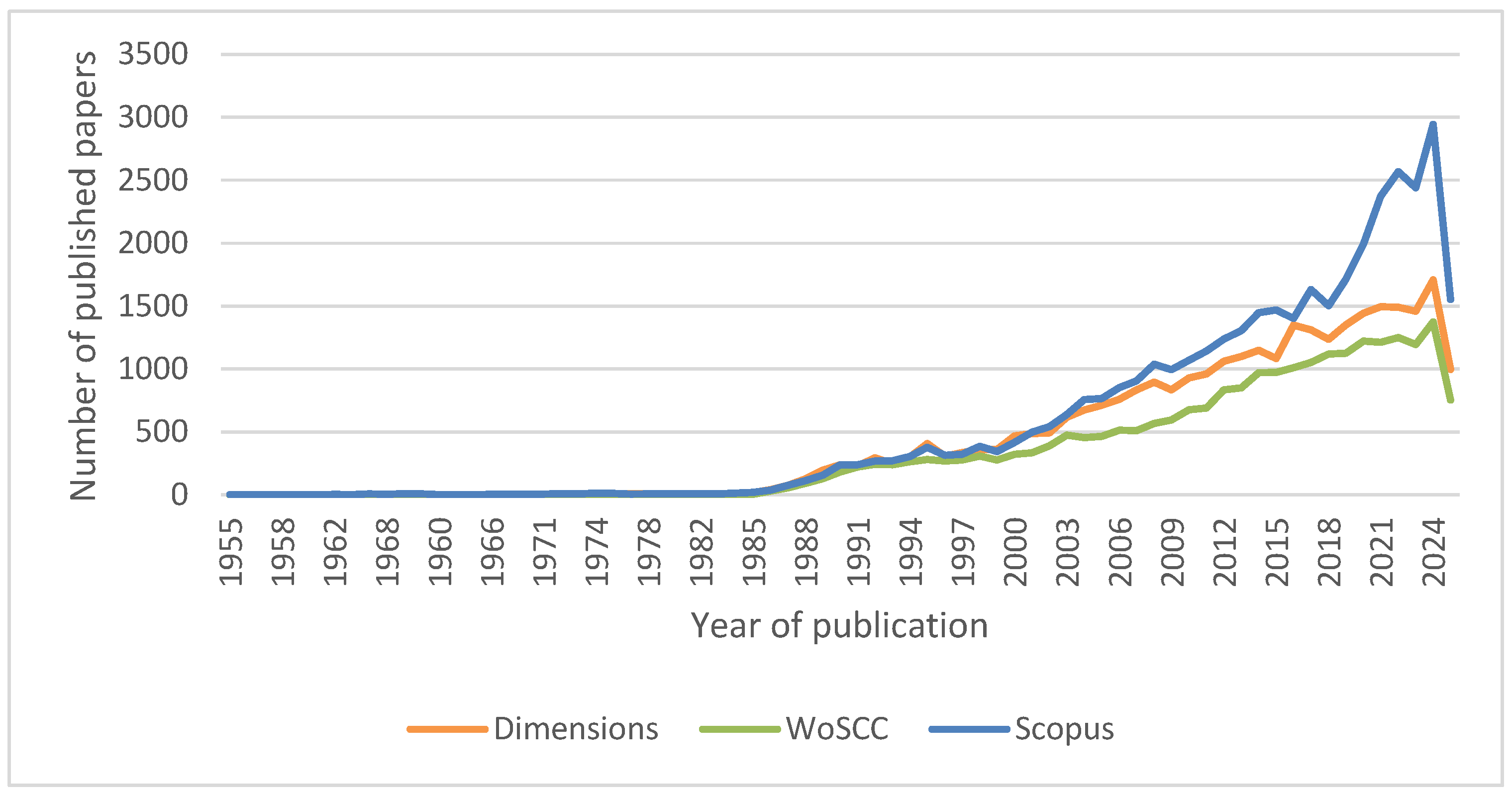



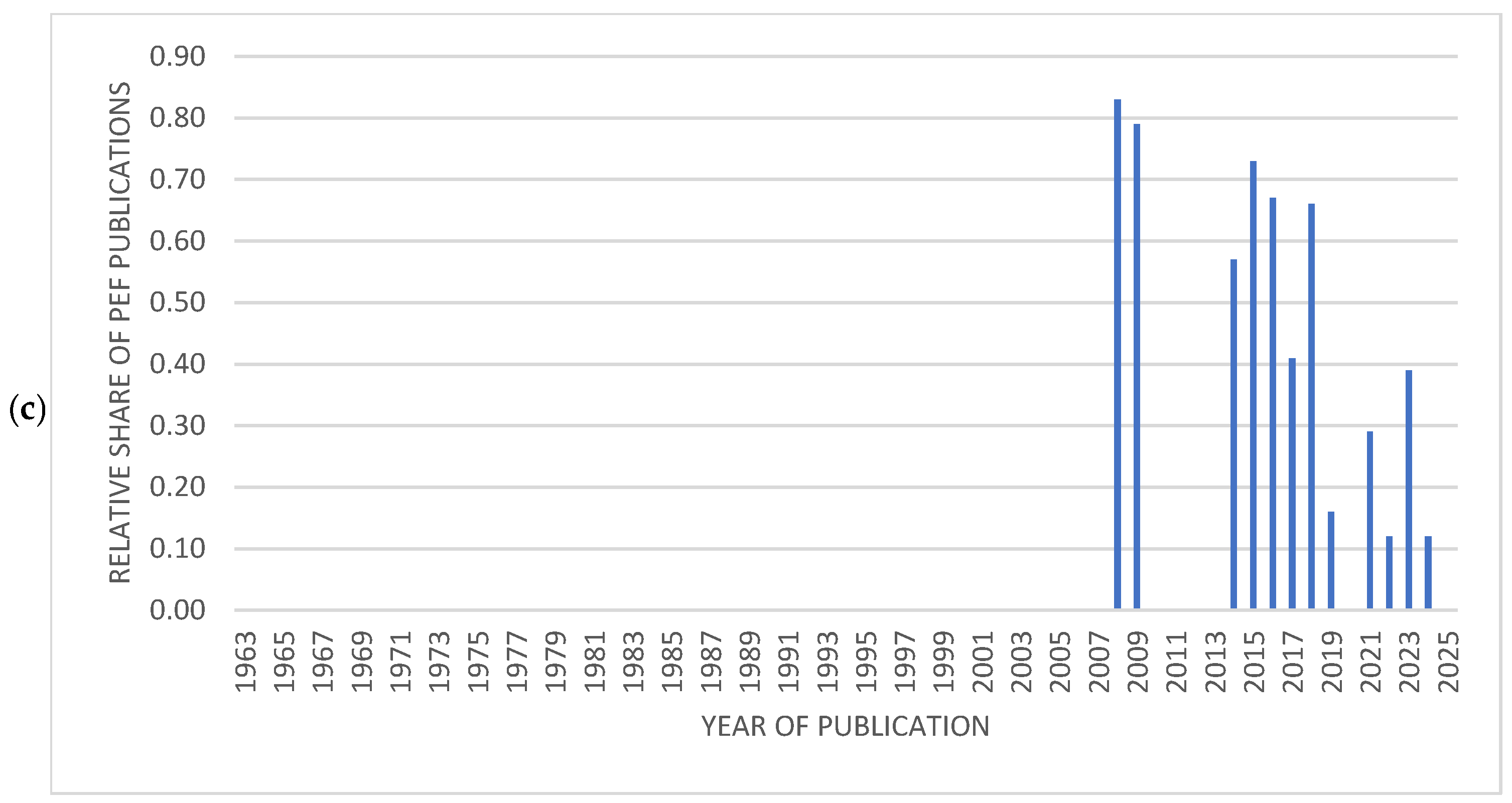
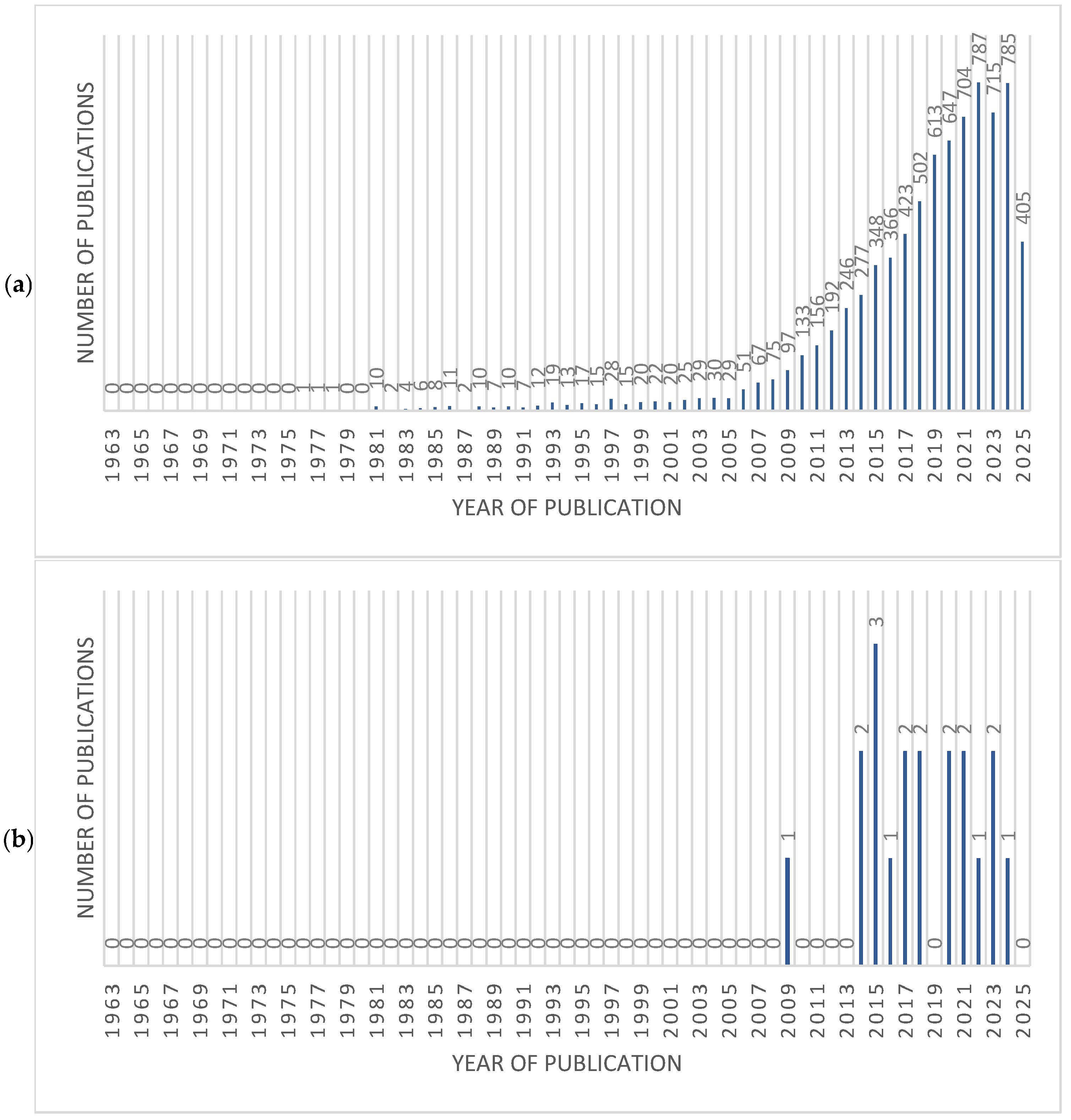
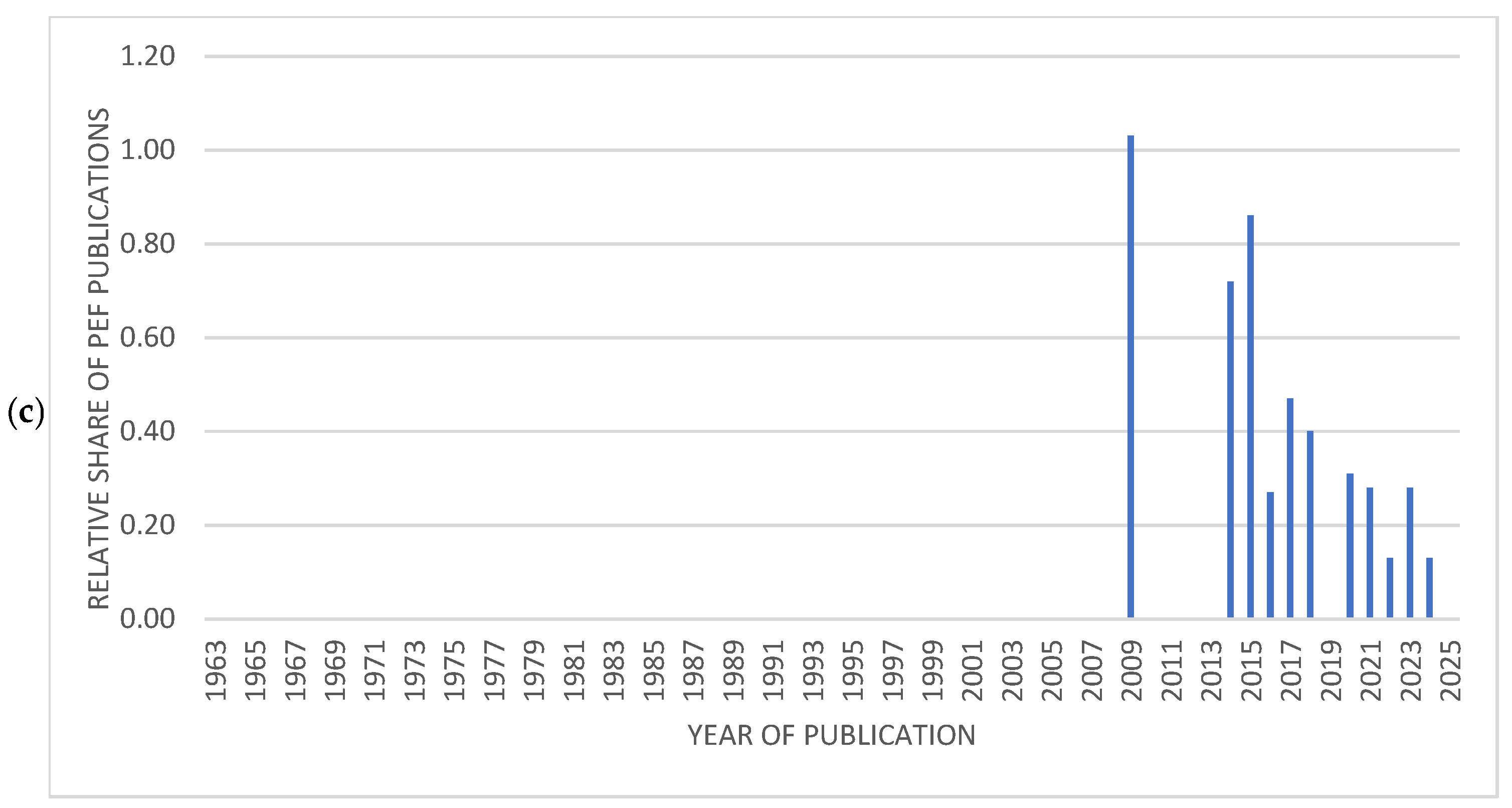
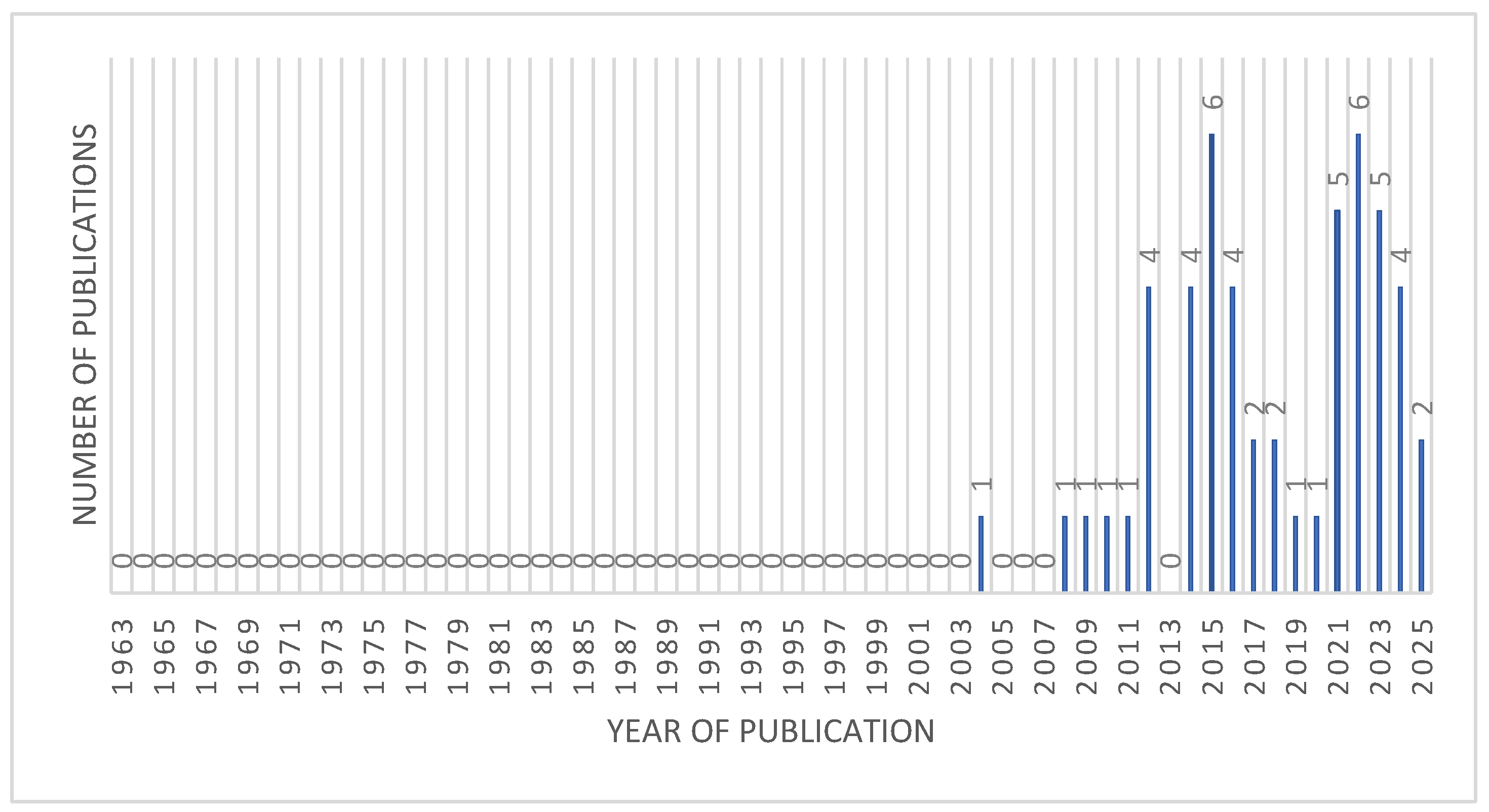

| Database | Established | Approximate Coverage (Millions) | Access | Search Capabilities | Citation Export Support | References |
|---|---|---|---|---|---|---|
| WoS | 1964 | 182 | Subscription | Advanced | Full support | [37,49,50] |
| Scopus | 2004 | 100 | Subscription | Advanced | Full support | [36,51,52] |
| Google Scholar | 2004 | 389 * | Free | Not supported | Not available | [45,46,47,48,53] |
| Dimensions | 2018 | 147 | Partially free ** | Limited | Basic support | [54,55,56] |
| Search Focus | Search Date | Final Number of Records Retrieved | Note |
|---|---|---|---|
| General search on PEF/electroporation (all fields) | July 2025 | WoSCC: 23,922; Scopus: 38,790; Dimensions: 30,524 | Provides an overview of overall PEF research activity across scientific fields |
| Biomass pretreatment before AD (any type of pretreatment) | July 2025 | WoSCC: 11,323; Scopus: 9172; Dimensions: 6054 | Allows comparison between the total number of pretreatment studies and the subset focused on PEF |
| PEF pretreatment before AD | July 2025 | WoSCC: 27; Scopus: 25; Dimensions: 19; Google Scholar: not available—manual screening | Represents the final dataset of PEF-related studies selected for detailed analysis |
| Manual screening and duplicate removal | July 2025 | Total relevant studies included: 66 | Both the peer-reviewed and grey literature |
Disclaimer/Publisher’s Note: The statements, opinions and data contained in all publications are solely those of the individual author(s) and contributor(s) and not of MDPI and/or the editor(s). MDPI and/or the editor(s) disclaim responsibility for any injury to people or property resulting from any ideas, methods, instructions or products referred to in the content. |
© 2025 by the author. Licensee MDPI, Basel, Switzerland. This article is an open access article distributed under the terms and conditions of the Creative Commons Attribution (CC BY) license (https://creativecommons.org/licenses/by/4.0/).
Share and Cite
Kovačić, Đ. Mapping Research Trends in Pulsed Electric Field Technology Applied to Biogas Production: A Comprehensive Bibliometric Analysis. Fuels 2025, 6, 69. https://doi.org/10.3390/fuels6030069
Kovačić Đ. Mapping Research Trends in Pulsed Electric Field Technology Applied to Biogas Production: A Comprehensive Bibliometric Analysis. Fuels. 2025; 6(3):69. https://doi.org/10.3390/fuels6030069
Chicago/Turabian StyleKovačić, Đurđica. 2025. "Mapping Research Trends in Pulsed Electric Field Technology Applied to Biogas Production: A Comprehensive Bibliometric Analysis" Fuels 6, no. 3: 69. https://doi.org/10.3390/fuels6030069
APA StyleKovačić, Đ. (2025). Mapping Research Trends in Pulsed Electric Field Technology Applied to Biogas Production: A Comprehensive Bibliometric Analysis. Fuels, 6(3), 69. https://doi.org/10.3390/fuels6030069







